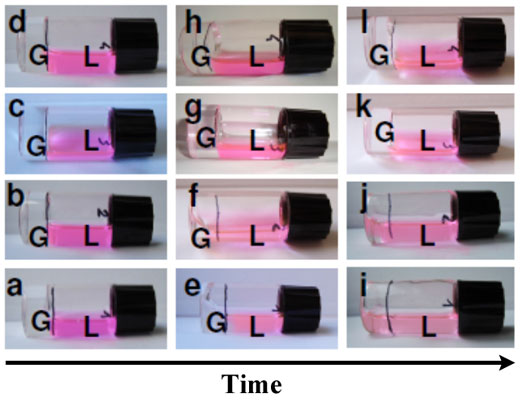- Home
- News
- Spotlight on Science
- Spontaneous glass-glass...
Spontaneous glass-glass transition in soft matter
24-06-2014
Soft matter systems offer the possibility to study new phase and/or state transitions as they are characterised by unconventional phase diagrams encompassing fluid, gel and glassy states. Researchers from the Italian CNR, in collaboration with staff at the ESRF, have discovered a spontaneous glass–glass transition in a colloidal clay through a combination of dilution experiments, X-ray photon correlation spectroscopy, small angle X-ray scattering, rheological measurements and Monte Carlo simulations. These findings open interesting perspectives on the microscopic control of the long term macroscopic stability of amorphous materials like glasses.
Recent advances in the study of soft materials have led to a deeper knowledge of equilibrium and non equilibrium states and to the discovery of new states/phases besides the ones commonly experienced in atomic or molecular systems. Of particular interest are glass–glass transitions, which are quite rare, especially those found at ambient conditions. We have discovered a spontaneous glass-glass transition in a colloidal clay without changing any external parameter.
Figure 1 shows a dilution experiment that allowed us to distinguish between two different glasses. The first glass melts upon addition of water within three days after arrest took place, (Figure 1 i-j). This glass is dominated by repulsion (Wigner glass) [1]. The second glass does not melt upon addition of water three days after arrest took place (Figure 1 k-l). Here an additional mechanism, probably due to attraction [2], has intervened. These results suggest that a previously unreported transition occurs in such glass Laponite dispersions at Cw=3.0% around a critical time tc≈3 days.
To further investigate this glass-glass transition, XPCS measurements have been performed at beamline ID10A. Intensity autocorrelation functions for rejuvenated samples are shown in Figure 2a. The derived dynamic structure factor is described by the Kohlrausch–Williams–Watts expression f(Q, t)=B∙exp[-(t/τ)β] where τ is an ‘effective’ relaxation time whose distribution is measured by the exponent β. Two different types of behaviour are again observed upon varying the rejuvenation time, tR: samples rejuvenated before tc show a stretched behaviour (β<1) while samples rejuvenated after tc exhibit a compressed behaviour (β>1) [3]. To complement these observations, the structure of rejuvenated samples was also investigated by performing SAXS measurements at beamline ID02. The measured static structure factors SM(Q) are shown in Figure 2b. Two different behaviours were found for samples rejuvenated before tc (black curves) with respect to samples rejuvenated after tc (red curves) showing a shift of the main peak to larger wave vectors (inset of Figure 2b) and a moderate increase of the low Q signal, that is, of the compressibility. To gain information on the macroscopic differences between the two glasses, oscillatory rheological measurements were performed at different times. A significant change of the elastic modulus G'(ν) as a function of frequency is shown in Figure 2c. For times above tc, G'(ν) is about one order of magnitude higher (G'~104 Pa) with respect to the value measured for times below tc (G'~103 Pa). Such an increase was found in systems with depletion interactions when passing from a repulsive to an attractive glass. This result supports a scenario with the existence of two glasses with significantly different elastic properties and confirms the crucial role of attraction for the occurrence of the spontaneous glass–glass transition observed in Laponite suspensions around tc. Monte Carlo simulations of a simple model of Laponite platelets which combine both repulsive and attractive ingredients give a microscopic understanding of the transition and help to clarify the nature of the attraction.
All of the above observations, providing information on the microscopic structure (SAXS) and dynamics (XPCS) as well as on the macroscopic properties (dilution experiments and rheological measurements) and on the microscopic interactions (molecular dynamics simulations), indicate that two different glassy states are distinguishable with evolving waiting time: the first is dominated by long-range screened Coulombic repulsion (Wigner glass), while the second is stabilised by orientational attractions (DHOC glass, disconnected house of cards glass) occurring after a much longer time.
Principal publication and authors
A. Angelini (a,b), E. Zaccarelli (c,b), F.A. de Melo Marques (d), M. Sztucki (e), A. Fluerasu (f), G. Ruocco (b,d) and B. Ruzicka (a,b), Glass-glass transition during aging of a colloidal clay, Nat. Commun.5 4049 (2014).
(a) CNR-IPCF UOS Roma (Italy)
(b) Physics Department, Sapienza University, Roma (Italy)
(c) CNR-ISC, Roma Italy.
(d) Center for Life NanoScience, IIT@Sapienza, Istituto Italiano di Tecnologia, Roma (Italy)
(e) ESRF
(f) Brookhaven National Laboratory, NSLS-II, Upton, New York (USA)
References
[1] B. Ruzicka et al., Phys. Rev. Lett. 104, 085701 (2010).
[2] B. Ruzicka et al., Nature Mater. 10, 56 (2011).
[3] R. Angelini et al., Soft Matter 9, 10955 (2013).
Top image: Static structure factor and relative arrangement of clay platelets for the two observed glasses.





